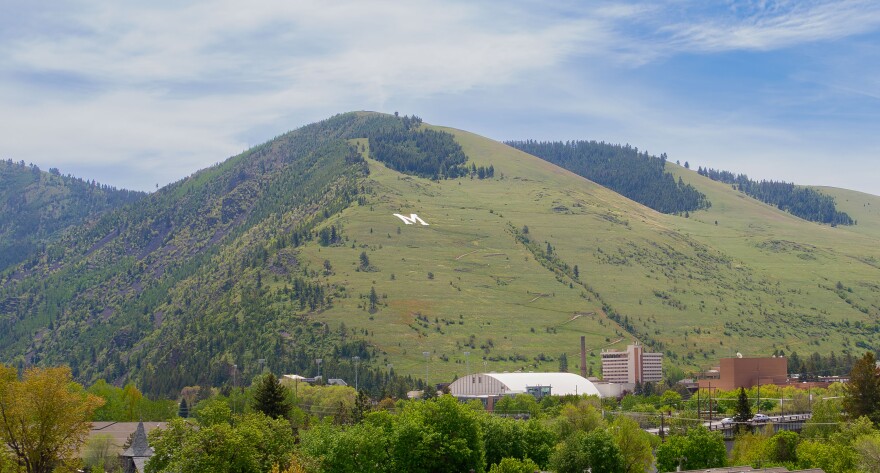Have you ever looked at a mountain and wondered why there were trees on one side but none on the other? Or noticed different species growing on opposite sides? Well, you barked up the right tree. Find out how trees choose sides in the mountain face off, right here on The Big Why.
Austin Amestoy: Welcome to The Big Why, a series from Montana Public Radio where we find out what we can discover together.
I’m your host, Austin Amestoy.
This is a show about listener-powered reporting. We’ll answer questions — large or small — about anything under the Big Sky. By Montanans for Montana, this is The Big Why.
Today, reporter Ellis Juhlin joins us to talk about trees! Ellis, hello!
Ellis Juhlin: Hey Austin, glad to be back on the show! Our question asker this week is Missoula listener Dave Slater.
Dave Slater: "I notice all over western Montana that many of the hillsides have a dense forest of trees on one side. However, the adjacent opposite facing slope just over the ridge will have almost no trees at all, making it look more like a grassy savannah. What's up with that?"
Austin Amestoy: Oh! I’ve had the same question hiking up the Sentinel trail to the top of Mount Sentinel. There's this heavily wooded area that feels really nice, and then you get to the other face of the mountain and you're just baking under the sun for the last mile, straight up hill. It is very strenuous.
Ellis Juhlin: That's so true Austin. I have had that experience more times than I would like.
Slater also mentioned that he thinks other people might have the same question.
Dave Slater: "I can't be the only one that is wondering this, you know? Because we all see it, and maybe some people know, but we don't really talk about it – or I haven't."
Austin Amestoy: Well I know I’m looking forward to finding out this answer! Ellis, how’d you do it?
Ellis Juhlin: So, I decided to hit the trail with Donny Perret. He's a local ecologist and postdoctoral researcher for the U.S. Forest Service. Perret studies trees and why they are found in certain places compared to others. So, he's the perfect person to answer this question. We met up for a morning hike on the Waterworks trail where you can look over at Mount Jumbo and Mount Sentinel, Missoula’s iconic “M” and “L” slopes above town.
Like you mentioned Austin, we can really see the phenomenon our listener was curious about in the city itself.

Donny Perret: "What's really interesting about this is that we're looking at different aspects of each mountain. So we're looking at the southwest side of one mountain and the north side of another. And just looking at them, they look very, very different. One's mostly bare with some patches of trees, and one's totally covered with really dense forest."
Ellis Juhlin: And that word, aspect, is really the key to answering this question. It refers to which direction a slope faces. And different aspects experience a vastly different climate, Perret told me.
Donny Perret: "So a north aspect gets less sun, right? It's a colder place. And if you're walking around the landscape in the winter, you'll find that there's often deeper snow, more snow, and it persists later in the season on that north aspect than on the south aspect, where everything melts off quickly."
He explained north aspects are colder and wetter, which means there’s more moisture in the soil, so more plants can grow. And trees, especially, need a good amount of water.
Donny Perret: "You'll have trees that are typically associated with colder environments on those north aspects, and trees that are typically associated with hotter, drier environments on those south aspects."
Austin Amestoy: Wow! That makes sense, I do see more snow on that north facing side of Mount Sentinel all winter long.
Ellis Juhlin: Exactly! This is the first difference between these two sides of the hills that we can talk about: the type of vegetation present. On those north facing aspects, you’ll notice lots of Douglas fir and larch trees. On those more south aspects you’ll see a lot more open space. But where there are trees, they’ll probably be ponderosa pines on those south slopes. Those specific conifers can handle that hotter, drier climate.
Perret says these different tree communities on different aspects have a lot to do with solar radiation. That’s basically a fancy term for when an area is getting hit by direct sun.
Donny Perret: "So the sun rises in the east, right? So that means that east aspects get early morning sun. So, they're getting all that radiation when the air temperature is fairly low and relative humidity is fairly high. That'll create a very, very different physical environment for the plants that are growing there, than on a west aspect, which gets late afternoon sun.”
This helps us account for that “savannah effect” our question-asker was curious about. Perret explained that since west slopes are getting that direct sun late in the afternoon when the temperatures are higher and relative humidity is lower, it makes for the much drier environment we see on those slopes. Much drier, hotter slopes can lead to more sparse vegetation, though of course other factors influence that too.

Austin Amestoy: So, does that mean you only see these different trees, or open grassy areas, on those specific slopes?
Ellis Juhlin: You’d think! But I asked Perret a similar follow up and he said it’s not quite that simple. He said we could actually take a larch tree from Sentinel and plant it on Jumbo or take a ponderosa pine from Jumbo and plant it onto Sentinel.
Donny Perret: "They would survive just fine. It's not like they can't tolerate those conditions, which begs the question of why they're not everywhere. That starts getting into some of the differences in different tree species' adaptations and life history strategies."
Think about a ponderosa pine. It's an iconic tree for this area. Their bark smells like butterscotch, especially if you sniff it on a hot day. One thing about ponderosa, Perret told me, is that they don’t like shade. When they’re tiny little seedlings, they don’t do well when they’re crowded out by other growth that shades out the sun. So, they tend to grow in those more open areas, like we see on the southwest-facing aspect of Jumbo. Ponderosas also rely more on things like fire to open up the canopy to give them access to sunlight to grow. And they’re better suited to fire than some of our other tree species.
Douglas fir, on the other hand, tend to do a bit better in those shady spots, since new fir seedlings can come up in thick forests, like those colder, wetter, north-facing aspects that are more dense in vegetation.
Austin Amestoy: We've been talking about this phenomenon in respect to those famous mountains in Missoula, but I'm betting this is not unique to Missoula.
Ellis Juhlin: It’s not. Perret has studied why trees grow where they do – and the differences between that within a specific region – all over the world.
Donny Perret: "This is not something that's unique to this valley or to this region, or to this continent or to this latitude. Vegetative communities – so, forests, the plants that grow under them – vary depending on the aspect of the hillside they occur on."
Ellis Juhlin: To be clear, the precise species that thrive growing on north or south or east or west facing slopes vary based on where you’re at. But these patterns in aspect and solar radiation remain constant.
There are other things that factor in too, even in other parts of Montana, Perret said. For example, precipitation, or how much rain and snowfall an area gets, is another big factor.
But ultimately, the pattern our listener Dave Slater noticed is informed by aspect of the slope and the temperature and moisture that comes with it. I circled back with Slater and let him know the answer to his question ahead of this episode airing.
Dave Slater: "That's interesting to me, because, like, the contrast is so remarkable to where you can draw a line and see, you know, where that tree line stops.
"Thank you for doing the work for, you know, talking to the folks that know the science behind it."
Austin Amestoy: Well Ellis, thank you so much for your tree reporting. It's always great to have you on.
Ellis Juhlin: Thanks Austin!
Austin Amestoy: Now we want to know what makes you curious about Montana. Submit your questions below, or leave a message at 406-640-8933. Let's see what we can discover together! Find us wherever you listen to podcasts and help others find the show by sharing it and leaving a review.
-
How do cabbage and spices become ingredients for community building? In Korea, the answer is kimjang, the fall tradition of making and sharing kimchi. This week on The Big Why, we visit a farm in the Bitterroot Valley where a group of Montanans came together to keep a food custom alive and find comfort and connection among the cabbage.
-
In Montana, abortion access has been at times illegal, legal, and stuck in limbo. Providers have weathered bombings and arson, advocates and opponents have battled it out in court, and citizens have passed a constitutional amendment affirming a woman's right to choose. One listener wants to know more about the history of reproductive rights in Montana. MTPR's Aaron Bolton reports on the underground networks, political violence and landmark court cases that got us to where we are today.
-
A flag's primary purpose is to be recognized from a distance. That means few colors, no lettering and a clear distinction from other flags. Ideally, it should be simple enough for a child to draw it from memory. So, how did Montana end up with such a complicated flag? Learn more in this episode of The Big Why.
-
Everywhere you look in Montana, there are places to gamble. Odds are good you've seen machines in bars, liquor stores and of course, gas stations. How did Montana end up with so many "casinos," and what does it have to do with bingo? The only sure bet is that The Big Why team has the answers.








